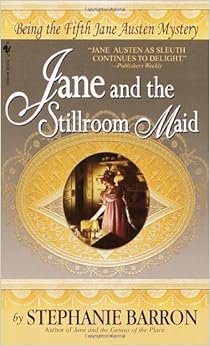One of the joys of reading Barron's fifth entry, Jane and the Stillroom Maid, has been spotting the various Pride and Prejudice influences, starting with the setting of the story which is in Derbyshire. As many a P&P fan knows, that section of England is the fictional home of Mr. Darcy, the rather proud owner of Pemberley and the house that inspired that grand place is also included here.
Before we get to that, the novel sends us off with Jane,her sister Cassandra and their widowed mother(whose nerves are very Mrs. Bennet-like) on a trip through Derbyshire with their cousin Rev. Cooper, a man fond of singing hymns and extolling the virtues of his noble patron, Sir George Mumps. A more Mr. Collins type of fellow could not be found,indeed:
When Jane joins in on a fishing trip with Mr. Cooper and a local friend of his, solicitor George Hemmings, she happens upon the dead body of what appears to be a young man.
As it turns out, the deceased is a young woman dressed up in gentleman's clothes by the name of Tess Arnold. Tess was the stillroom maid(as well as the neighborhood medicine woman) at Penfolds Hall and recently dismissed from her position due to a possible affair with Andrew Danforth, the younger brother of the family.
Tess' death is strange enough but there are suspicions aroused by the local coroner Michael Tivey, about the Freemasons being involved in the crime, many of whom are prominent members of the community,including Charles Danforth, the current master of Pendfolds whose wife and children died under mysterious circumstances in which Tess might be brought to blame.
To make matters worse, George Hemmings disappears from the area,despite being a key witness to the discovery of Tess' remains and quite a scene is created at the inquest,where Jane does testify, that throws everything into an uproar:
A calming force amidst the chaos is the arrival of Sir Harold Trowbridge, Jane's "Gentleman Rogue" who is eager to clear the Freemasons of any blame as well as assist in finding the true killer.
That search for justice takes Jane and Lord Harold to Chatsworth House,which was the architectural muse for Pemberley, and connections are made with the family of the recently deceased Georgiana, the famed Duchess of Devonshire.
While Jane's mother is not happy about her youngest daughter's crime solving ways(or the Whig Party ties that Chatsworth has), she is hoping for Jane to make a match with Lord Harold, something that Jane does briefly entertain the notion of but knows full well that, unlike her new set of noble acquaintances, such a thing is not to be:
Despite these romantic thoughts, Jane is able to focus on the task at hand which becomes all the more pressing when a confession to the crime is made by someone she suspects is truly innocent.
I have to say that pace of this book is much livelier than the previous installment in this series(Jane and the Genius of the Place), with a good amount of humor,both verbal and otherwise-let's just say that Austen women know how to defend themselves with crockery!
Lines from Pride and Prejudice are cleverly woven into several conversations throughout the course of the story, adding a nice nuance without being too distracting from the main plot. Plus, the addition of real life figures,such as Lady Harriot Cavendish and Elizabeth "Bess" Foster, as supporting players enriched the historical elements of the story just right.
All in all, I found Jane and the Stillroom Maid to be a fine read and now that I've read the first five books in this series(along with a couple of later ones as well), that I will keep up with the rest of Stephanie Barron's books.
As for my next Series-ous Reading selection, it'll be doing double duty as The Mark of the Midnight Manzanilla by Lauren Willig is also on my TBR for the FrightFall readathon next month.
The reason for this is due to the vampire theme of the story, as the heroine of the story, Sally Fitzhugh, is influenced by a popular novel that has a nocturnal Romeo at it's center. Sort of sounds like a Regency version of Twilight but more than likely, the book in question has more in common with the kind of "horrid" books that Catherine Morland from Northanger Abbey preferred to swoon over, we shall see!:




No comments:
Post a Comment